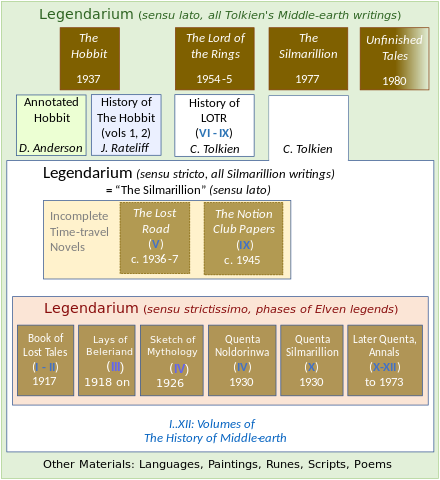
Back Tolkiens Welt German Legendarium Spanish Legendarium Basque رشتهافسانههای تالکین Persian Légendaire de Tolkien French O legendarium de Tolkien Galician הלגנדריום של טולקין HE Tolkien legendáriuma Hungarian Legendarium Italian ლეგენდარიუმი Georgian

Tolkien's legendarium is the body of J. R. R. Tolkien's mythopoeic writing, unpublished in his lifetime, that forms the background to his The Lord of the Rings, and which his son Christopher summarized in his compilation of The Silmarillion and documented in his 12-volume series The History of Middle-earth. The legendarium's origins reach back to 1914, when Tolkien began writing poems and story sketches, drawing maps, and inventing languages and names as a private project to create a mythology for England. The earliest story, "The Voyage of Earendel, the Evening Star", is from 1914; he revised and rewrote the legendarium stories for most of his adult life.
The Hobbit (1937), Tolkien's first published novel, was not originally part of the larger mythology but became linked to it. Both The Hobbit and The Lord of the Rings (1954 and 1955) took place in the Third Age of Middle-earth, while virtually all of his earlier writing had been set in the first two ages of the world. The Lord of the Rings occasionally alludes to figures and events from the legendarium to create an impression of depth, but such ancient tales are depicted as being remembered by few until the story makes them relevant.
After The Lord of the Rings, Tolkien returned to his older stories to bring them to publishable form, but never completed the task. Tolkien's son Christopher chose portions of his late father's vast collection of unpublished material and shaped them into The Silmarillion (1977), a semi-chronological and semi-complete narrative of the mythical world and its origins. The sales were sufficient to enable him to work on and publish many volumes of his father's legendarium stories and drafts; some were presented as completed tales, while others illustrated his father's complex creative process. Tolkien research, a continuing examination of Tolkien's works and supporting mythology, became a scholarly area of study soon after his death.
© MMXXIII Rich X Search. We shall prevail. All rights reserved. Rich X Search